Gasch R., Twele J. (Eds.) Wind Power Plants: Fundamentals, Design, Construction and Operation
Подождите немного. Документ загружается.

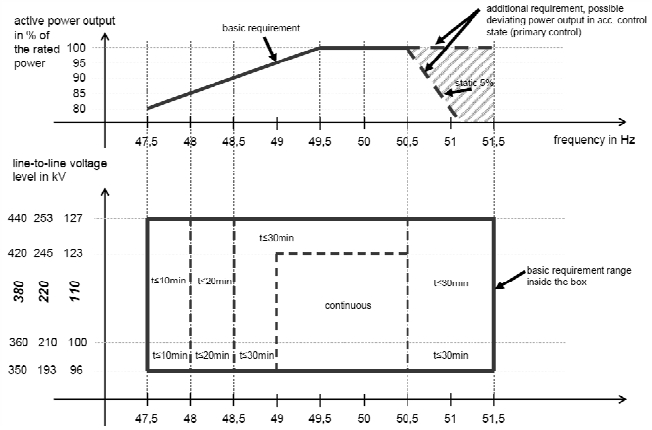
472 14.2 Wind turbines in the interconnected electrical grid
For the switching-on procedure of the wind farm it is required that the switching-
on current of the wind farm must not exceed 120% of the current corresponding to
the grid connection capacity. Therefore, it may be required to connect the wind
turbines to the grid one after the other.
With regard to reactive power, it is required that, by means of a set value signal
sent by the grid operator, the power factor of the wind turbines at active power
production can be adjusted between 0.975 (inductive) and 0.975 (capacitive) ac-
cording to the situation. In this context the internal lines of the wind farm and the
transformers must also be taken into consideration.
There are three requirements for active power production:
x The maximum admissible gradient of the active power after neutral state
is 10% of the grid connection capacity per minute. This may be realised
by forced sequential switching-on of the wind turbines in a wind farm.
x Temporal limitation or switching-off the active power is required for
critical load conditions in the grid.
x The admissible voltage-frequency range is given in Fig. 14-12. The wind
farm has to be switched off immediately when deviations occur below
and above the admissible frequencies (47.5 Hz and 51.5 Hz). In the fre-
quency range between 50.25 Hz and 51.5 Hz the active power production
of the wind farm has to be limited at rising frequency.
frequency in Hzfrequency in Hz
Fig. 14-12 Voltage-frequency-active power requirement (quasi-stationary, i.e. frequency gradi-
ent < 0.5% / min, voltage gradient 5% / min), from E.ON grid code April 2006 [11]
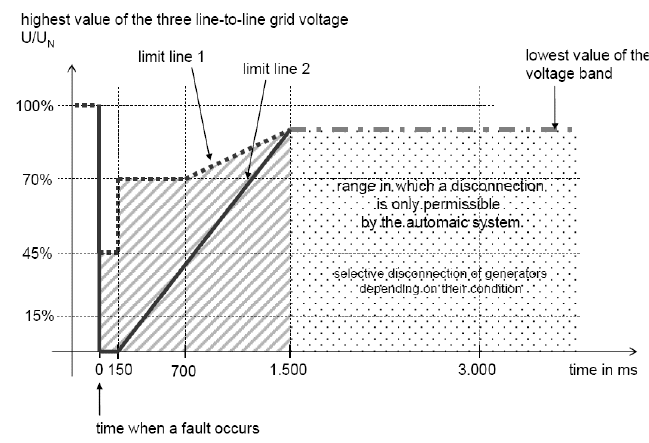
14 Wind turbine operation at the interconnected grid 473
Fig. 14-13 Required behaviour of a wind turbine during a voltage drop due to grid fault, from
[11]
As long as the wind power input into the grid was negligible, the turbines were
simply shut down in case of a grid fault due to short-circuit. Today’s rules are far
more complicated since the proportion of electricity fed by the wind turbines may
be significant, cf. Fig. 14-5. If the wind turbines are connected to the grid by con-
verters they are still able to feed into the grid during a grid short-circuit, thereby
stabilising the grid. By contrast, for stall-regulated wind turbines with a direct grid
connection of the asynchronous generator, the excitation of the generator collapses
during a short-circuit and, therefore, they are no longer able to provide power dur-
ing a grid short-circuit.
Short-time short-circuits occur quite frequently in the grid at overhead lines.
Snow, a wet branch or even a big bird, for example, may temporarily connect two
of the lines and then fall down. Immediately, the automatic reclosure briefly dis-
connects the grid line and verifies one or two seconds later if normal operation can
be relaunched upon rectification of the disturbance. If this is the case the wind tur-
bines must also provide power immediately. Thus, the following rules in case of
grid faults have been established:
x During a grid short-circuit (grid voltage above 60 kV) the highest possi-
ble reactive current has to be provided for up to 3 seconds in the 3
rd
quad-
rant. This is only required during grid faults and for a voltage range
between 15% and 60% of the operating voltage U
0
at the grid connection
point.

474 14.2 Wind turbines in the interconnected electrical grid
x There must be no disconnection from the grid if, in the event of a fault in
the grid, the voltage level at the grid connection point is above the limit
curves of the grid voltage shown in Fig. 14-13.
The wind turbine manufacturer has to prove that the turbine type satisfies the grid
code by suitable measurements and possibly additional simulation calculations.
Furthermore, rules exist in order to verify that the individual wind turbine or wind
farm installed satisfies the grid codes [15, 16].
14.2.2 Interaction between grid and wind turbine operation -
network interaction and grid compatibility
Network interactions refer to all those influences on the electricity grid which lead
to deviations in the following characteristics: voltage amplitude, voltage and cur-
rent curve and grid frequency. A phase shift alone between current and voltage is
not a network interaction since it meets none of the four criteria above. Network
interactions are distinguished according to the frequency and duration of the fault
and the resulting effects in current and voltage, table 14.1.
Table 14.1 Network interactions, frequency range and causes [18]
Parameter Peri-
odic
Non-
periodic
Frequency
range in Hz
Cause
Harmonics
Intermediate harmon-
ics
Sub harmonics
x
x
x
x
> 50
0 ... > 50
< 50
Non-linear
consumers,
Switching
process
Voltage fluctuations
Flicker
x
x
x
x
< 0.01
0.005 … 35
Power fluctua-
tions
Transient x > 50 Switching
process
Voltage drop
Voltage collapse
x
x
< 50
< 50
Grid fault
Asymmetric voltage - - - Asymmetric
load
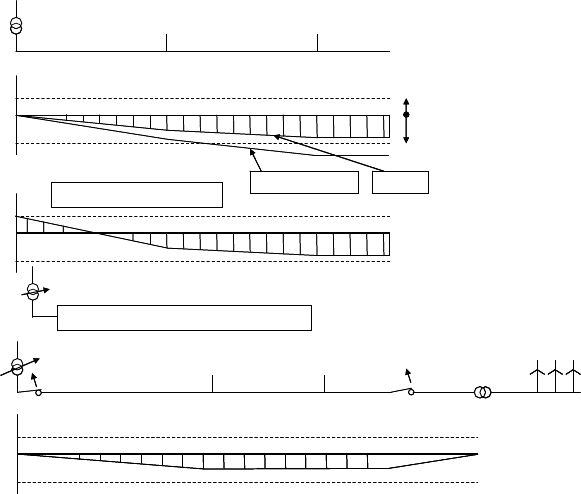
14 Wind turbine operation at the interconnected grid 475
20 kV
Village A Village B
100 %
Voltage compensation
90 %
100 %
normalhigh consumption
+
-
Tolerance
Transformer with on load tap changers
Voltage
Village A
Village B
Grid switch
Grid switch
100 %
20 kV
Village A Village B
100 %
Voltage compensation
90 %
100 %
normalhigh consumption
+
-
Tolerance
Transformer with on load tap changers
Voltage
Village A
Village B
Grid switch
Grid switch
100 %100 %
Fig. 14-14 Voltage compensation, top: by changing the transformer voltage (no wind turbines),
bottom: by wind energy fed into the grid
Fig. 14-14, top, shows the voltage along a local overhead line at normal and at
very high load. At high loads voltage compensation may be necessary using a
transformer with on-load tap changer to increase the feeding voltage so that it is
kept within the tolerated range between +5% and -10%, Fig. 14-14, middle. How-
ever, if there is additional power input by wind turbines at the line end, these
measures may not be required any more, Fig. 14-14, below.
Another issue involved in grid-connected wind turbine operation are so-called
flicker. Low-frequent voltage fluctuations may cause variations in the light density
of light bulbs. Flicker frequencies between 8 and 9 Hz are quite disturbing for the
human eye, Fig. 14-15. In course of the grid compatibility (i.e. power quality)
measurements at a wind turbine, the flicker coefficient c is determined and has to
be mentioned together with the other electrical characteristics in the wind tur-
bine’s specifications, see comparison of various wind turbines, e.g. in [19]. For
most stall-regulated wind turbines, the flicker coefficient is higher than for pitch-
controlled wind turbines. Moreover, the variation of the flicker coefficient with
the phase angle has to be documented in the test reports.
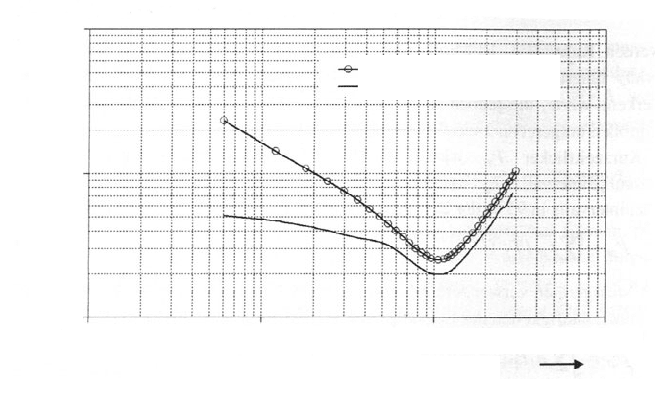
476 14.2 Wind turbines in the interconnected electrical grid
Number of voltage changes per minute
(Frequency of voltage change in Hz)
10 (0.08) 100 (0.83) 1,000 (8.33) 10,000
Sinusoidal change
Rectangular change
10
1
0.1
dU/U [%]
Number of voltage changes per minute
(Frequency of voltage change in Hz)
10 (0.08) 100 (0.83) 1,000 (8.33) 10,000
Sinusoidal change
Rectangular change
10
1
0.1
dU/U [%]
Fig. 14-15 Tolerance level for periodical rectangular and sinusoidal voltage changes according
to EN 61000-3 3 and IEC 1000-3-3 [18]
14.2.3 Characteristics of wind turbine concepts for grid-connected
operation
The wind turbine concepts presented in chapter 13 differ in terms of their grid
compatibility. As already mentioned, one aspect of the effects of the wind turbine
operation on the grid is its demand for reactive power or the ability to provide it.
Basically, stall-regulated wind turbines with a directly grid-connected asynchro-
nous generator require reactive power which has to be delivered by the grid. This
demand may be reduced, but not eliminated, by capacitor banks for reactive power
compensation (cf. chapter 13). For newly grid-connected wind turbines grid opera-
tors require that the power factor of the wind turbine (i.e. the ratio of reactive and
active power) be adjusted depending on the load situation in the power line
branch, Fig. 14-16. Modern wind turbines with converters fulfil this requirement.
For older wind turbines with direct grid connection of the asynchronous generator,
retrofit packages with power controllers exist for this purpose. Table 14.2 summa-
rizes the key advantages and disadvantages of the different wind turbine concepts.
For information on harmonic waves the interested reader should refer to the litera-
ture, e.g. in [7, 14, 17, 18, 20].
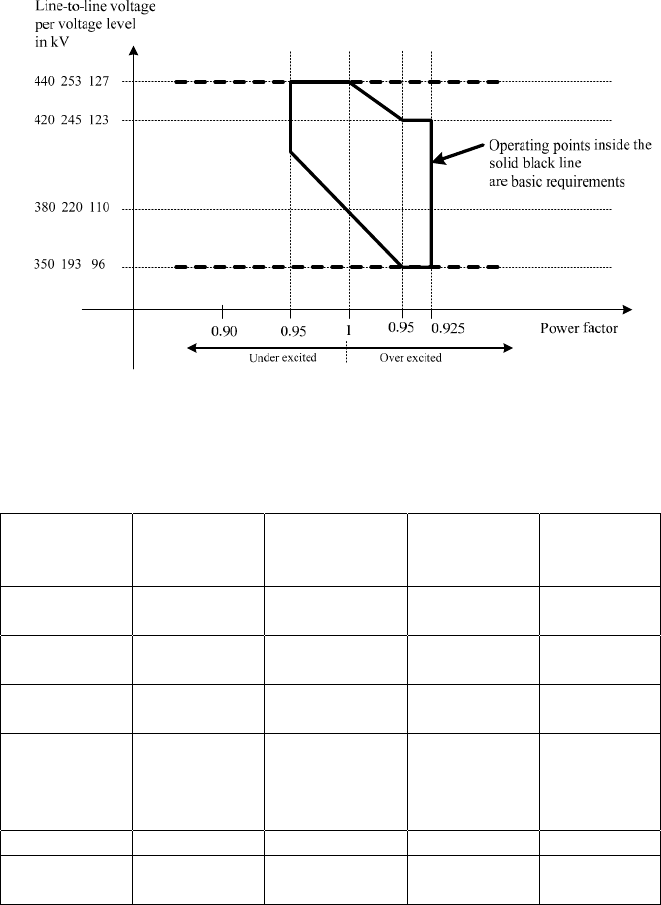
14 Wind turbine operation at the interconnected grid 477
Fig. 14-16 Required range of the power factor during the turbine operation without limiting the
effective power output [16]
Table 14.2 Assessment of wind turbine concepts concerning their grid compatibility [17, 19]
Generator
type
Asynchro-
nous
Asynchronous,
Variable slip
Asynchro-
nous, doubly-
fed
Synchro-
nous
Rotational
speed
Rigid (nearly
constant)
Soft variable variable
Grid connec-
tion
direct direct Via converter Via con-
verter
Reactive
power
consumption Consumption adjustable adjustable
Power at
grid connec-
tion point
x*P
N
Approx.
1.30 to1.50
Approx.
1.05 to 1.10
Approx.
1.05 to 1.10
Approx.
1.00 to 1.05
Flicker High Medium Medium Low
Harmonics Not relevant Existent Partially ex-
istent
Not rele-
vant
In conclusion, it may be emphasised that modern wind turbines fulfil the grid
codes required by grid operators. Moreover, despite the unsteady wind being their
energy source their electricity generation may nowadays be quite accurately pre-
dicted. This is a very important issue particularly in relation to the liberation of the
478 14.2 Wind turbines in the interconnected electrical grid
European electricity market. In 2005, a drought of several months in Spain led to a
severe lack of electricity generation due to low water levels in barrages and re-
sulted in power plants being shut down as well due to shortage of cooling water.
The Spanish demand was met by electricity from Germany (especially hydro due
to strong rain), France and Scandinavia. This was delivered in a reliable and cost-
effective manner even at peak load despite the thousands of kilometres of power
lines between and within the countries. The grid structures in Europe already al-
low for large-scale transmission of electricity generated from renewable energies.
Therefore, initial studies are being carried out on the grid integration of electricity
generated from renewable energy in North Africa.
References
[1] Union for the Coordination of Transmission of Electricity (UCTE), www.ucte.org,
Brussels, 2005
[2] Verband der Netzbetreiber VDN e.V. beim VDEW (Association of German Grid
Operators, www.vdn-berlin.de, Berlin, 2005
[3] Deutsche Energieagentur (dena): Energiewirtschaftliche Planung für die
Netzintegration von Windenergie in Deutschland an Land und Offshore bis zum Jahr
2020 (On planning of the energy management of wind energy grid integration in
Germany on- and offshore until the year 2020), Berlin 2005
[4] Rohrig, K., et al.: Online-Monitoring and prediction of wind power in German
transmission system operator centres, Proc. of EWEC 2003, Madrid 2003
[5] Ensslin, C.: Large-Scale Integration of Wind Power, in “Grid-connected Wind
Turbines”, Post-Graduate Training Programme 2003, InWEnt gGmbH, Deutsche
WindGuard Dynamics GmbH, ISET Kassel e.V.
[6] Beck, H.-P., Clemens, M.: Konditionierung elektrischer Energie in dezentralen
Netzabschnitten (Conditioning electrical energy in decentral grid sections), etz, 5/2004
[7] Heier, S.: Windkraftanlagen – Systemauslegung, Integration, Regelung (Wind Energy
Converters – System design, integration and control), Teubner Verlag, 3
rd
ed., 2003
[8] Schlögl, F.: Online-Erfassung und Prognose der Windenergie im praktischen Einsatz,
(Practical applications of online acquisition and prediction of wind energy) I/FS,
Köln, Juli 2005, e.g. on www.iset.uni-kassel.de/prognose
[9] Windenergie Report Deutschland 2002, Jahresauswertung des "Wissenschaftlichen
Mess- und Evaluierungsprogramms" (WMEP) zum Breitentest "250 MW Wind"
(German Wind Energy Report 2002, Annual evaluation of the „scientific measuring
and evaluation programme“ of the large-scale testing programme „250 MW Wind“),
Institute for Solar Energy Supply Technology ISET e.V., Kassel 2002
[10] Burges K., Twele J.: (Ecofys GmbH): Wind farms participating in TSO’s Power Sys-
tem Management, Deutsche Windenergie Konferenz (DEWEK), Wilhelmshaven, 2004
[11] Santjer, F., Klosse, R.: Die neuen ergänzenden Netzanschlussregeln von E.ON Netz
GmbH (The new additional grid codes by E.ON grid), DEWI-Magazine No. 22,
February 2003
[12] Franken, M.: Sächsisches Wunderwerk (Miracle of Saxony), Janzing, B.: Schnell
aufladen, schnell einspeisen (Fast charging and feeding electricity), Lönker, O.:
Zukunftsspeicher (Future storage systems), in: Neue Energie (new energy) 04/2005
[13] ENERCON AG: Brochure of the wind turbine E33, 2005
[14] Ackermann, T. (Ed.): Wind Power in Power Systems, John Wiley & Sons, Ltd.,
Stockholm 2005
14 Wind turbine operation at the interconnected grid 479
[15] Verband der Netzbetreiber VDN e.V. beim VDEW: EEG-Erzeugungsanlagen am
Hoch- und Höchstspannungsnetz (Electricity generating plants powered by renewable
energies and connected to the high and extra-high voltage grid), August 2004,
www.vdn-berlin.de, Berlin
[16] E. ON Netz GmbH: Netzanschlussregeln (Grid Codes), Stand August 2003, Bayreuth
[17] Schulz, D.: Netzrückwirkungen – Theorie, Simulation, Messung und Bewertung
(Network interconnections – theory, simulation, measurement and assessment), VDE
series 115, 1
st
ed., VDE Verlag, Berlin 2004
[18] Schulz, D: Untersuchung der Netzrückwirkungen durch netzgekoppelte Photo-voltaik-
und Windkraftanlagen (Investigations on network interactions of grid-connected
photovoltaic and wind power plants), Ph.D thesis at the Technical University of Berlin,
2002, publisher: VDE-Verlag GmbH 2002
[19] Bundesverband WindEnergie e.V., BWE Service GmbH (Ed.): Windenergie 2005,
Marktübersicht (Wind Energy 2005 – A market survey)
[20] Quaschning, V.: Regenerative Energiesysteme (Renewable Energy Systems),
publisher: Carl Hanser Verlag, 2003
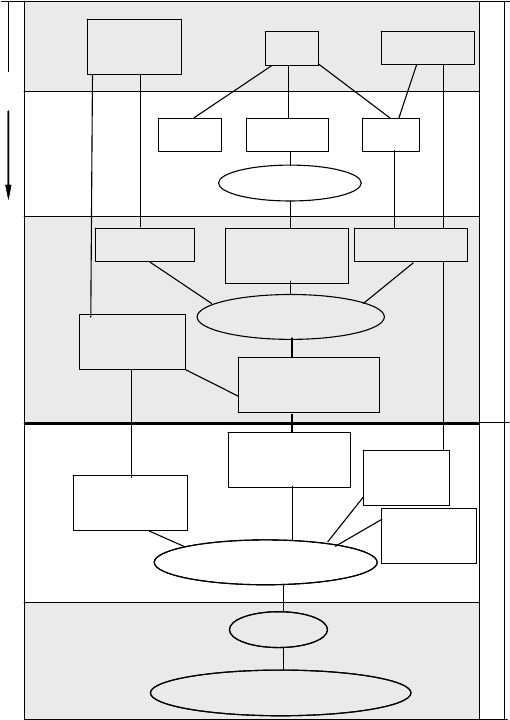
R. Gasch and J. Twele (eds.), Wind Power Plants: Fundamentals, Design, Construction 480
and Operation, DOI 10.1007/978-3-642-22938-1_15, © Springer-Verlag Berlin Heidelberg 2012
15 Planning, operation and economics of wind
farm projects
This chapter is structured according to the chronology of the individual working
phases of a wind farm project: preliminary and project planning, erection and
operation. Each phase may be differentiated according to the following aspects:
- Technical aspects
- Aspects of the permission regulation and
- Economic aspects.
Planning stage
RealisationOperation
Prelimin-
ary step
Laws,
Finances
Site
analysis
Economic
efficiency
Contract of
financing
Feed-in
contract
Construction
permit
Erection / Commissioning
Operation
Deconstruction / Repowering
Corporate
foundation
Wind Ground Grid
Contract
of sale
Site
Lease contract
Financing WEC / GridPlanning of
Construction
Technics
Application for
building, EIA
Time
Chapter 15.1Chapter 15.2
Planning stage
RealisationOperation
Prelimin-
ary step
Laws,
Finances
Site
analysis
Site
analysis
Economic
efficiency
Contract of
financing
Feed-in
contract
Construction
permit
Erection / CommissioningErection / Commissioning
OperationOperation
Deconstruction / RepoweringDeconstruction / Repowering
Corporate
foundation
Wind Ground Grid
Contract
of sale
Site
Lease contract
Financing WEC / GridPlanning of
Construction
Technics
Application for
building, EIA
Time
Chapter 15.1Chapter 15.2
Fig. 15-1 Flow chart of a wind farm project
15 Planning, operation and economics of wind farm projects 481
15.1 Wind farm project planning
Fig. 15-1 shows schematically the chronology of the planning procedure until pro-
ject realisation and operation. In the preliminary investigation the project feasibil-
ity at the chosen site is analysed before formal and cost intensive steps are taken.
15.1.1 Technical planning aspects
Estimation of the wind regime
In course of the site selection the estimation and assessment of the wind regime is
of prime importance since, as already mentioned several times, if the mean wind
speed is 10% less than estimated the energy yield may be reduced by 30% and
more. The first step includes the assessment of the determined wind speed values
obtained e.g. by general meteorological data, and moreover the verification of the
orography at the site, the terrain structure, the surface roughness (cf. chapter 4)
and as well the type and size of the terrain boundaries. Moreover, single obstacles
like rows of trees or other wind turbines have to be registered exactly. Even at this
stage, it is necessary to consult an experienced planning expert who should then
determine the further procedures and methodologies to be employed for the
detailed determination of the wind potential. Different procedures for the site
assessment were presented in chapter 4. Depending on the local conditions but
also on the quality of possibly available regional wind data, e.g. from measuring
stations, the applicable method is chosen and decided to which extent own wind
measurements are required. The decision criteria have already been mentioned in
section 4.5.
First estimation of the installed capacity and expected energy yield
Apart from the available area of the site, the available grid connection is a decisive
factor in determining the number and rated power of turbines to be installed.
Therefore, it is reasonable to send an enquiry to the local grid operator at an early
stage in order to check the possible grid connection capacity, the distance to the
next potential feed-in point and the voltage level of the grid connection (cf.
chapter 14).
It may be reasonable or necessary to build a separate sub-station for larger
capacities (> 20 MW). These two boundary conditions (available area of the site and
grid capacity) may be used to estimate the number and rated power of the wind
